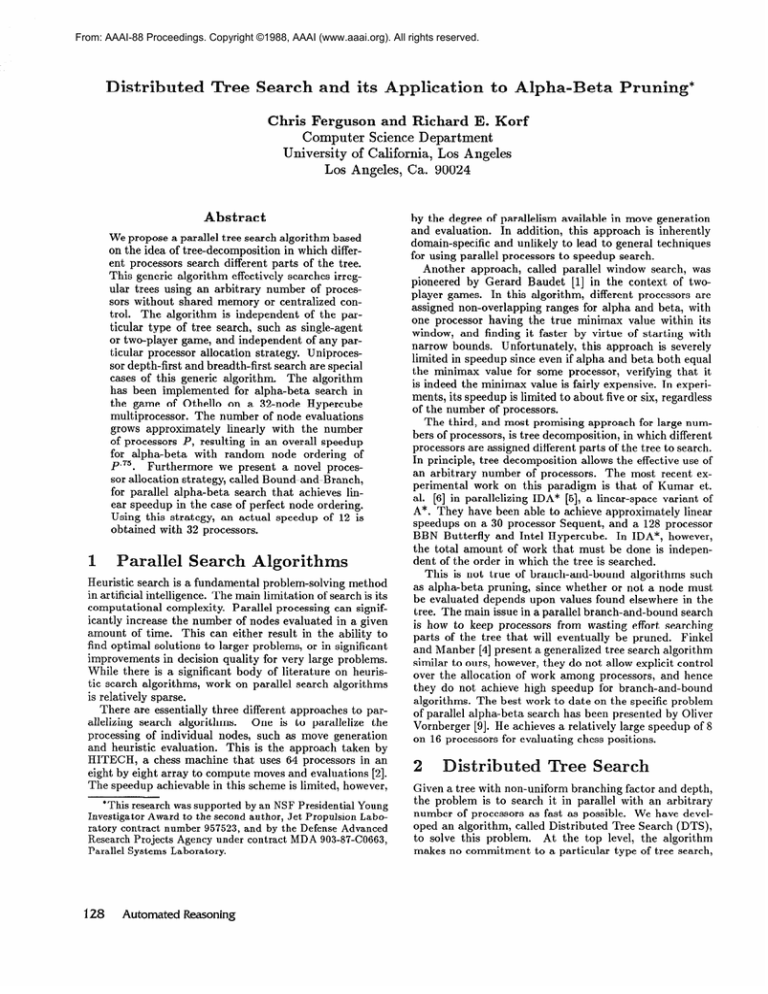
From: AAAI-88 Proceedings. Copyright ©1988, AAAI (www.aaai.org). All rights reserved.
Distributed
Tree Searc
and its Application
to Alpha-Beta
Pruning*
Chris
Ferguson and Richard E. Korf
Computer Science Department
University of California, Los Angeles
Los Angeles, Ca. 90024
Abstract
We propose a parallel tree search algorithm
based
on the idea of tree-decomposition
in which different processors
search different parts of the tree.
This generic algorithm
effectively
searches irregular trees using an arbitrary
number of processors without
shared memory or centralized
control.
The algorithm
is independent
of the particular
type of tree search,
such as single-agent
or two-player
game, and independent
of any particular processor
allocation
strategy.
Uniprocessor depth-first
and breadth-first
search are special
cases of this generic algorithm.
The algorithm
has been implemented
for alpha-beta
search in
the game of Othello
on a 32-node
Hypercube
multiprocessor.
The number of node evaluations
grows approximately
linearly
with the number
of processors
P, resulting
in an overall speedup
for alpha-beta
with random
node ordering
of
p.75
.
Furthermore
we present
a novel processor allocation
strategy,
called Bound-and-Branch,
for parallel
alpha-beta
search that achieves
linear speedup in the case of perfect node ordering.
Using this strategy,
an actual speedup of 12 is
obtained
with 32 processors.
1
arallel
Search
Algorithms
Heuristic
search is a fundamental
problem-solving
method
in artificial intelligence.
The main limitation
of search is its
computational
complexity.
Parallel
processing
can significantly increase the number of nodes evaluated
in a given
amount of time.
This can either result in the ability to
find optimal solutions
to larger problems,
or in significant
improvements
in decision quality for very large problems.
While there is a significant
body of literature
on heuristic search algorithms,
work on parallel search algorithms
is relatively
sparse.
There are essentially
three different approaches
to parOne is to parallelize
the
allelizing
search
algorithms.
processing
of individual
nodes, such as move generation
and heuristic
evaluation.
This is the approach
taken by
HITECH,
a chess machine
that uses 64 processors
in an
eight by eight array to compute moves and evaluations
[2].
The speedup achievable
in this scheme is limited, however,
*This research was supported by an NSF Presidential Young
Investigator Award to the second author, Jet Propulsion Laboratory contract number 957523, and by the Defense Advanced
Research Projects Agency under contract MDA 903-8’7-C0663,
Parallel Systems Laboratory.
128
Automated
Reasoning
by the degree of parallelism
available
in move generation
and evaluation.
In addition,
this approach
is inherently
domain-specific
and unlikely to lead to general techniques
for using parallel processors
to speedup search.
Another
approach,
called parallel
window search, was
pioneered
by Gerard
Baudet
[l] in the context
of twoIn this algorithm,
different
processors
are
player games.
assigned non-overlapping
ranges for alpha and beta, with
one processor
having the true minimax
value within its
window, and finding it faster by virtue of starting
with
narrow bounds.
Unfortunately,
this approach
is severely
limited in speedup since even if alpha and beta both equal
the minimax
value for some processor,
verifying
that it
is indeed the minimax
value is fairly expensive.
In experiments, its speedup is limited to about five or six, regardless
of the number of processors.
The third, and most promising
approach
for large numbers of processors,
is tree decomposition,
in which different
processors
are assigned different parts of the tree to search.
In principle,
tree decomposition
allows the effective use of
an arbitrary
number of processors.
The most recent experimental
work on this paradigm
is that of Kumar
et.
al. [S] in parallelizing
IDA* [5], a linear-space
variant of
A*. They have been able to achieve approximately
linear
speedups
on a 30 processor
Sequent,
and a 128 processor
BBN Butterfly
and Intel Hypercube.
In IDA*,
however,
the total amount of work that must be done is independent of the order in which the tree is searched.
This is not true of branch-and-bound
algorithms
such
as alpha-beta
pruning,
since whether or not a node must
be evaluated
depends upon values found elsewhere
in the
tree. The main issue in a parallel branch-and-bound
search
is how to keep processors
from wasting effort searching
parts of the tree that will eventually
be pruned.
Finkel
and Manber [4] present a generalized
tree search algorithm
similar to ours, however, they do not allow explicit control
over the allocation
of work among processors,
and hence
they do not achieve high speedup
for branch-and-bound
algorithms.
The best work to date on the specific problem
of parallel alpha-beta
search has been presented
by Oliver
large speedup of 8
Vornberger
[9]. H e achieves a relatively
on 16 processors
for evaluating
chess positions.
2
istribute
ee Search
Given a tree with non-uniform
branching
factor and depth,
the problem
is to search it in parallel
with an arbitrary
number of processors
as fast as possible.
We have developed an algorithm,
called Distributed
Tree Search (DTS),
At the top level, the algorithm
to solve this problem.
makes no commitment
to a particular
type of tree search,
but can easily be specialized
to IDA*, minimax with alphaIt can also be specialized
to perform
beta pruning,
etc.
most tasks that can be expressed
as tree recursive
procedures such as sorting
and parsing.
We make no assumptions
about the number of processors,
and reject algorithms
based on centralized
control or shared memory,
since they do not scale up to very large numbers
of processors.
DTS consists of multiple
copies of a single process that
combines both searching and coordination
functions.
Each
process is associated
with a node of the tree being searched,
and has a set of processors
assigned
to it. Its task is to
search the subtree
rooted at its node with its set of processors.
DTS is initialized
by creating
a process, the root
process, and assigning the root node and all available processors to it.
The process expands
its node, generating
its children,
and allocates
all of its processors
among its
children according
to some processor
allocation
strategy.
For example,
in a breadth-first
allocation
scheme, it would
deal out the processors
one at a time to the children until the processors
are exhausted.
It then spawns a process
for each child that is assigned at least one processor.
The
parent process then blocks, awaiting a message.
If a process is given a terminal
node, it returns the value of that
node and the processors
it was assigned immediately
to its
parent, and terminates.
As soon as the first child process completes
the search of
its subtree,
it terminates,
sending a message to its parent
with its results, plus the set of processors
it was assigned.
Those results may consist of success or failure, a minimax
value, values for alpha or beta, etc., depending
on the application.
This message
wakes up the parent process to
reallocate
the freed processors
to the remaining
children,
and possibly send them new values for alpha or beta, for
example.
Thus, when a set of processors
completes
its
work, the processors
are reassigned
to help evaluate other
parts of the tree.
This results in efficient
load balancing
in irregular
trees.
A process may also be awakened
by
its parent with new processors
or bounds to be sent to
its children.
Once the reallocation
is completed,
the parent process blocks once again, awaiting
another
message.
Once all child processes
have completed,
the parent process returns
its results
and processors
to its parent and
terminates.
DTS completes
when the original root process
terminates.
In practice,
the blocked processes,
corresponding
to high
level nodes in the tree, exist on one of the processors
assigned to the children.
When such a process is awakened, it
receives priority over lower level processes for the resources
of its processor.
Once the processors
get down to the level
in the tree where there is only one processor
per node, the
corresponding
processor
executes
a depth-first
search.
In fact, uniprocessor
depth-first
search is simply a special case of DTS when it is given only one processor.
Given
a node with one processor,
the processor
is allocated
to
the first child, and then the parent process blocks, waiting for the child to complete.
The child then allocates
its
processor
to its leftmost
child and blocks, awaiting its return. When the grandchild
returns,
the child allocates
the
processor
to the next grandchild,
etc. This is identical
to
depth-first
search where the blocked processes
correspond
to suspended
frames in the recursion
stack.
Conversely,
if DTS is given as many processors
as there
are leaves in the tree, and the allocation
scheme is breadthfirst as described
above, it simulates
breadth-first
search.
In effect, each of the children
of each node are searched
in parallel
by their own processor.
With an intermediate number
of processors,
DTS executes
a hybrid between depth-first
and breadth-first
search,
depending
on
the number of processors
and the-allocation
scheme.
sute-Force
Searc
DTS has been implemented
to search Othello game trees
using a static evaluation
function
we developed.
It runs
on a 32 node Intel Hypercube
multiprocessor.
When the
algorithm
is applied to brute-force
minimax search without
alpha-beta
pruning,
perfect speedup is obtained
to within
less than 2%. This 2% difference is due to communication
and idle processor
overhead.
This demonstrates
that even
though the branching
factor is irregular,
the reallocation
of
processors
performs
effective load balancing.
As a result,
we expect near-optimal
speedup for most forms of bruteforce search.
4
Achieving
linear
speedup
for branch-and-bound
algorithms,
such as alpha-beta
search,
is much more challenging.
There are two sources of inefficiency
in parallel
branch-and-bound
algorithms.
One is the communication
overhead associated
with message
passing
and idle processor time.
This also occurs
in brute-force
search but
is negligible
for DTS, as shown above.
The other source
of inefficiency
derives from the additional
nodes that are
evaluated by a parallel algorithm
but avoided by the serial
version. In branch-and-bound
algorithms,
the information
obtained
in searching
one branch of the tree may cause
other branches
to be pruned.
Thus, if the children are
searched in parallel,
one cannot take advantage
of all the
information
that is available to a serial search, resulting in
wasted work, which we call the search overhead.
5
Consider a parallel branch-and-bound
algorithm
on a uniform tree with brute force branching
factor B and depth
D. The e$ective
branching f&orb
is a measure of the efficiency of the pruning and is defined as the Dth root of the
total number of leaf nodes that are actually
generated
by
a serial branch-and-bound
algorithm
searching
to a depth
D. While the brute-force
branching
factor B is constant,
the effective
branching
factor b depends on the order in
which the tree is searched.
In the worst case, when children are searched in order from worst to best, no pruning
takes place and thus b = B. In the best case of alpha-beta
pruning,
in which the best child at each node is searched
first, b = B1j2.
If a tree is searched in random order, then
alpha-beta
produces an effective branching
factor of about
b = B.75 [7]. I n t erestingly,
for breadth-first
allocation,
the
more effective
the pruning,
the smaller the speedup over
uniprocessor
search.
Theorem
1: If b = BX on a uniform
tree then
DTS using breadth-first
allocution will achieve a speedup
of O(PX).
Ferguson
and Korf
129
256
A: Optimal
B: Analytical
128
for breadth-fist
C: Breadth-first
64
D: Bound-and-Branch
E: B&B without communication
1
I
2
I
4
overhead
I
I
I
8
16
32
Processors (log scale)
I
64
Figure 1
Graph of Speedup Versus Number of Processors
130
Automated Reasoning
I
128
256
Proof:
The speedup of a parallel algorithm
is the time
taken by a serial algorithm,
divided by the time taken by
thegarallel
algorithm.
The serial algorithm
will evaluate
BX
leaf nodes, resulting
in a running time proportional
to BXD.
The parallel
algorithm
uses P processors
allocated in a breadth-first
manner.
Processors
will be passed
down the tree until there is one processor
assigned
per
node. This occurs at a depth of logB P. Each one of these
processors
will evaluate O(BX(D-‘ogB
p)) nodes even if no
new bounds are passed to it since each is searching a tree of
depth D - logB P by itself. Thus, this simple parallel algorithm takes time proportional
to BxcD-‘OgB p). Therefore,
the speedup is on the order of BX log, p, or O(Px).
6
readth-First
Allocation
We have searched
40 mid-game
Othello
positions
to a
depth of 6 using the breadth-first
allocation
scheme on
1, 2, 4, 8, 16 and 32 processors
on a X&node Intel Hypercube. Results were also obtained for 64, 128, and 256 processors by simulating
multiple
virtual processors
on each
of the 32 actual processors
available.
With one processor the algorithm
performs
serial alpha-beta
search.
The
communication
overhead for the parallel versions is always
less than 5%, leading to an almost linear relation between
the number of processors
and number of node evaluations
per unit time.
This is expected
due to the near perfect
speedup obtained
for brute-force
search.
This also allows
us to estimate
speedup by counting
the total number of
node evaluations
in serial, and dividing that by the number of evaluations
per processor
performed
in parallel.
On
32 processors,
the parallel alpha-beta
algorithm
evaluates
about 3 times as many leaf nodes as the serial version. This
results in a speedup of only 10 over uniprocessor
alpha-beta
search. Our program uses a very primitive,
but reasonably
effective, form of node ordering.
From previous research,
this ordering was found to produce an effective branching
with our Othello
factor of b M B.66 for serial alpha-beta
heuristic
function.
This predicts a parallel speedup of approximately
P .66. Figure 1 is a graph on a log-log scale of
speedup verses number of processors.
The analytical
and
actual speedup results for breadth-first
allocation
are represented by curves B and C. From these curves it can be
seen that the results for breadth-first
allocation
fit the analytical curve very closely, thus supporting
our analytical
results.
If the node ordering is improved,
however, even though
the parallel algorithm
will run faster, the relative speedup
over uniprocessor
alpha-beta
search will decrease.
In particular, if the best move from a position is always searched
first (perfect
move ordering),
serial alpha-beta
will evaluate only Bd12 leaf nodes,
and our formula
predicts
a
speedup of only P li2. This is also the lower bound speedup
predicted by Finkel and Fishburn
for their algorithm
in [3].
While one may think that perfect or near-perfect
node ordering is impossible
to achieve in practice,
state-of-the-art
chess programs such as HITECH
[2] only search about 1.5
times the number of nodes searched under perfect ordering.
In this case our algorithm
would have a predicted speedup
very close to its lower bound of P1i2.
Thus the performance of the breadth-first
allocation
scheme is relatively
poor under good node ordering,
and a better
allocation
strategy
is required.
ocation
We have developed
another
processor
allocation
strategy
for alpha-beta
search that we call Bound-and-Branch.
To
explain
this strategy,
we introduce
the idea of a cutoff
bound.
A cutoff bound is an alpha (lower) bound at a
max node or a beta (upper)
bound at a min node.
A
cutoff bound allows each child of a node to possibly
be
pruned by searching only one grandchild
under each child.
If no cutoff bound exists at a node, then the processors
are assigned depth first, i.e. all processors
are assigned to
the leftmost
child. This is the fastest way of establishing
a cutoff bound at a node.
If a cutoff bound is initially
passed to a node, or has been established
by searching its
first child, then the processors
are assigned in the usual
breadth-first
manner.
This algorithm
first establishes
a
bound, and then, once this bound is established,
branches
its processors
off to its children, thus the name Bound-andBranch.
The underlying
idea is to establish
useful bounds
before searching
children in parallel,
thus hopefully avoiding evaluating
extra nodes that would be pruned by the
serial version because of better available bounds.
Lines D and E in figure 1 represent
real speedup for
the Bound-and-Branch
allocation
scheme
(D), and the
speedup
not counting
communication
overhead
for the
Bound-and-Branch
allocation
strategy
(E). The communication
overhead
for the Bound-and-Branch
allocation
strategy
is about 25%.
This is caused by the added idle
processor
time and the added communications
associated
with splitting
up processors
lower in the tree as opposed
to splitting
them up as soon as possible.
Despite
this,
the Bound-And-Branch
allocation
strategy
outperforms
breadth-first
allocation
even without good node ordering.
Thus this strategy
is also useful for the general case of
imperfect
node ordering.
Furthermore,
we will show that
its speedup over serial alpha-beta
actually
improves with
better node ordering.
Theorem
2: In the case of perfect node ordering,
the Bound-and-Branch
allocation strategy will evaluate the
same nodes as serial alpha-beta.
Proof: In perfect node ordering, the first move searched
under a node is the best move from that position.
Furthermore, once a bound is established
for a node, it can never
be improved upon without refuting a first child as the best
possible move. For a node whose initial bound is a cutoff
bound, this bound renders the children of that node independent from one another in the sense that searching
any
first will never improve the bounds at their parent,
and
thus cannot
cause more cutoffs to occur when searching
the others. This implies that these nodes can be searched
in parallel without causing any extra evaluations
to occur.
Thus, since the Bound-and-Branch
allocation
strategy only
branches
out in parallel when a cutoff bound is available,
no extra node evaluations
can occur.
How well does this strategy
work in the case of no node
ordering,
good node ordering,
and near-perfect
node ordering?
To obtain better node ordering,
the Othello program was modified to perform iterative-deepening
alphabeta search [8]. I n an iterative-deepening
search, the game
tree is successively
searched to depths of 1, 2, 3, 4 . . . D.
Ferguson
and Korf
13 1
gies.
The algorithm
produces
near perfect
speedup
in
brute-force
searches
of irregular
trees without
relying on
We have shown
centralized
control
or shared memory.
that under a breadth-first
processor
allocation
strategy,
the speedup achievable
with parallel branch-and-bound
is
proportional
to Px, where P is the number of processors,
and X is a measure
of how effective
the the pruning
is.
We also introduced
a novel processor
allocation
strategy
for parallel alpha-beta
called Bound-and-Branch
that does
no more work than serial alpha-beta
in the case of perfect
node ordering and in general increases
in speedup as the
ordering technique
improves.
These algorithms
have been
implemented
to perform alpha-beta
search on a Hypercube
and currently
produce speedups of 12 on a 32-node Hypercube.
PI G.
Baudet,
“The design and analysis
of algorithms
for asynchronous
multiprocessors”,
Ph.D. dissertation,
Dept. Computer
Science,
Carnegie
Mellon University,
Pittsburgh,
PA., Apr. 1978.
PI Carl
Ebeling,
bridge, Mass.,
8
Conclusions
We have presented
a generic distributed
tree search algorithm that can be easily specialized
to different types of
search problems
and different processor
allocation
strate-
132
Automated
Reasoning
All The
1987.
Right
Moves,
MIT
Press,
Cam-
PI
R. Finkel and J. Fishburn,
“Parallelism
in Alpha-Beta
Search”,
Artificial
Intelligence,
Vol. 19, No. 1, Sept.
1982.
PI
R. Finkel, U. Manber,
“DIB - A Distributed
Implementation of Backtracking”,
ACM
Transactions
on Programming
Languages
and Systems,
Vol. 9, No. 2, Apr.
1987.
Fl
R. E. Korf, “Depth-first
iterative-deepening:
An optimal admissible
tree search”, Artificial Intelligence,
Vol.
27, No. 1, 1985, pp. 97-109.
PI
V. Nageshwara
Rao, V. Kumar,
K. Ramesh,
“A Parallel Implementation
of Iterative-Deepening
A*“, Proceedings of the National
Conference
on Artificial Intelligence
(AAAI-87),
Seattle,
Wash.,
July 1987, pp.
133-138.
PI
Judea
Mass.,
PI
D. J. Slate, L. R. Atkin, “CHESS
ern University
Chess Program”,
York, 1977.
PI
“Parallel
Alpha-Beta
versus
0. Vornberger,
SSS*“,
Proceedings
of the IFIP
Conference
tributed Processing,
Amsterdam,
Oct. 1987.
Pearl,
1984.
Heuristics,
Addison-Wesley,
Reading,
4.5 - The NorthwestSpringer-Verlag,
New
Parallel
on Dis-






